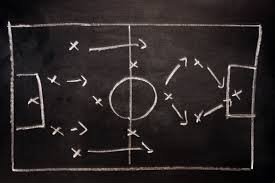No Tactics Until 13? Nonsense.
One of the most misunderstood and pervasive statements within youth development is the idea of “no tactics until 13” when teaching or coaching. It’s an idea that might be born out of good reasoning when put into context, but the issue remains that when coaches hear this they inevitably take this mantra to the utmost and treat it as dogma.
No tactics until 13 is just plain incorrect because it misunderstands what tactics mean as well as the necessary, important development process for young players.
No tactics until 13 may stem from the idea that 8 year old’s should not be taught how to play out of the back in a 4-3-3. There are much more important things to learn at that age, but the statement still remains, “No tactics until 13.” What does that mean then? To the average coach who is beginning to learn the game it acts as one of the most dangerously misleading sign-posts for someone who needs guidance and help as they develop. It’s too vague, it’s too ambiguous, because ultimately tactics are the foundation upon which technique is applied or executed correctly. Every action should have a thought behind it and at any age we should encourage decision-making skills.
Let’s look at what exactly tactics mean and then examine the issue that many players face at the older ages because of this pervasive mantra.
Various people will define tactics within soccer differently. Claudio Reyna through the USSF defines tactics as: “Individual or collective actions performed by a player or group of players to take advantage of an opponent, group of opponents or a team.
Explanation: The tactics are the tools to develop the strategy.
Example: Quick transition of the ball from one side of the field to the other.”
Another definition from the USSF via an E license manual defines tactics as : “the where, when, and why of soccer. Soccer is a team sport that allows each player to impose their personality into the game. The free flowing characteristics of soccer provides players numerous opportunities to make instant decisions while attacking or defending.”
Inevitably, however you want to define tactics, it requires players to be decision-makers. Tactics are everywhere. Tactics are in everything we do. Decision-making is a skill that can be enhanced or shunned depending on the coaching of the activity and every activity, whether a U7 session or a U18 session must contain decision-making (aka tactics) in the activities.
Every technique you work with your players on should have a tactical application behind it. If you’re working with 6 and 7 year old’s on dribbling and running with the ball, there must be a thought process there. “If I have the ball, do I want to kick it or control it?” More importantly perhaps, “When I have the ball with open space what do I do compared to when I have the ball but no open space?” These are tactics! When to dribble and when to pass? Tactics. When to dribble with big touches or when to dribble with small touches? Tactics. When to take a defender on or when to pass the ball to a teammate? Tactics. When, where, and why of anything with the game? Tactics.
This is not to say that the why is more important than the how at early ages. Indeed, the how to do things (the technique itself) is vastly important at the younger ages because players need to know how to do something properly before they can apply it within a certain context. A player who doesn’t know how to dribble won’t do much good even if he does know when he should dribble into open space or keep the ball in tight spaces. While technique must be constantly worked on, even at the youngest ages, there needs to be decision-making present in activities. While you may coach the technique at U8 more-so than the why or where, ONLY coaching the technique is a pitfall just as bad as ONLY coaching the tactics and disregarding the technique.
If you are running training sessions and only teaching the how, you are doing your players a disservice. The quote from Cruyff always comes to mind.
Don’t make the mistake and think your players can’t handle these ideas. They can and will if they are asked, but if they’re constantly in an environment where they don’t have to think, they are going to regress with their problem-solving skills. At the youngest ages I focus on open space and what to do. When our team has the ball do we want to spread out or do we want to all stand around one ball? When the other team has the ball should we all back away into the goal or should we go towards the ball to try an win it nearer to the other team’s goal, and why? Young kids can and should handle these questions, but they have to be asked in the appropriate setting and manner.
As players get older, we’re still well below the age of 13, can we focus on individual principles. When I have the ball can I penetrate? If my teammate has the ball can I support them either wide, high, or deep. When I’m defending, where should I run when approaching the defender and if my teammate is defending, where should I be to offer cover. These are not difficult concepts if they are worked on correctly and in the appropriate manner. Any technical game you incorporate can involve these decisions, and here is where you are still enhancing and working on technical development but ensuring that there is a thinking-side to each activity.
Understand, it is EASY to run a session and only coach the HOW. It is easy to “let the game be the teacher” by putting on activities and telling kids to pass to teammates using the inside of the foot, or dribble using their laces or the outside of the foot. It becomes harder when you have to actively coach and help your players understand why, when, and where to use laces when dribbling compared to the outside of the foot, or why, when, and where to pass the ball with the inside of the foot as compared to just explaining how to pass properly. The former may be “coaching,” but the latter is developing soccer players.
When we begin to develop decision-makers, we can hope to avoid the pitfalls of many current young players. All too often we develop players who can do 100 tricks and flicks but can’t pass a ball properly at the right speed, time, and foot. We live in a YouTube generation where the how to do 100 skills is seen and encouraged more than the how, when, where, and why to do 1 or 2 good skills. College players are entering higher levels of play without understanding the basic principles of play, whether it be pressure, cover, and balance for defense or penetration, support, or improvisation in attack.
Any player can learn how to do a scissor past a cone, but if the player is never tested in an environment where they have to take a defender on 1v1, they aren’t going to fully understand the proper application of a scissor. How often have you seen a player do a skill move when the opposing team isn’t anywhere close! This is the problem when technical development is encouraged without any tactical development.
Here is a video presented by a professional team as “Academy Tactics: U12”
The coach is quite clear in explaining that it is a technical passing activity, but the club itself promotes this as tactics. There is little to no thought process involved, with some instructions as to back foot or hip placement but little why. Is a 1 minute clip enough context? Perhaps not, but the fact that this is considered “tactics” is scary enough.
Ultimately, the best players and coaches are in an environment that fosters thinking. Tactics are thinking, and the game without thinking is no game at all. Do yourself and your players a favor, and begin to develop players who are technically competent and comfortable thinking for themselves.
-Paul Cammarata



Δεν υπάρχουν σχόλια:
Δημοσίευση σχολίου